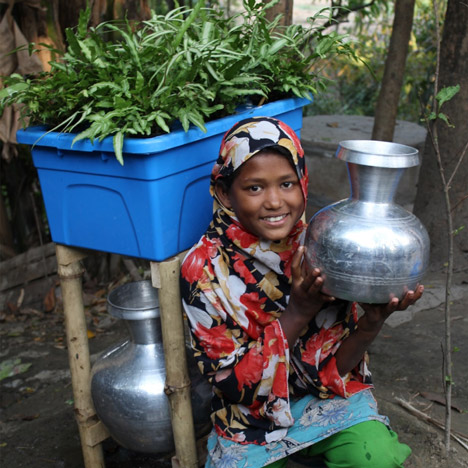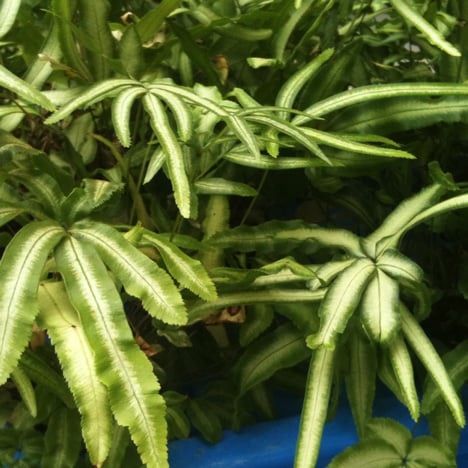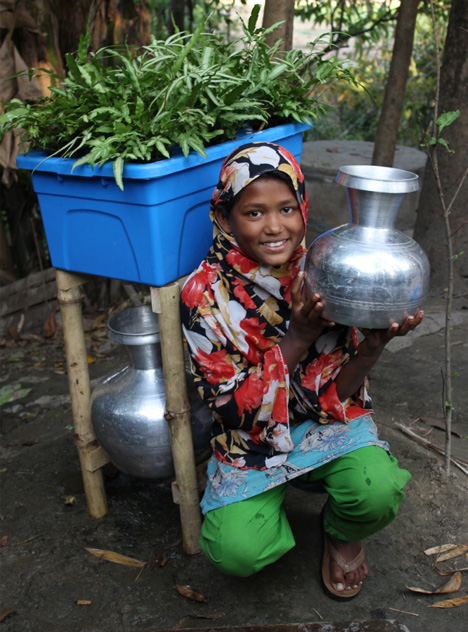
Plant-based water-purifying system named "Idea that will change the world"
News: a water-filtration system that uses plants to extract arsenic from water supplies and allows the user to sell the poisonous substance at a profit has been voted the "Idea that will change the world" at the Global Design Forum in London today (+ interview).
Clean Water, developed by Oxford University MSc student Stephen Goodwin Honan, was voted the best of five world-changing ideas presented at the forum, held today at the Southbank Centre.
Arsenic poisoning from contaminated water has been described as the "largest mass-poisoning in history" by the World Health Organisation, causing cancers that kill an estimated 1.2 million people in the developing world each year.

Clean Water uses special, arsenic-absorbing plants, which are grown in a container. Water is pumped through the container and arsenic is trapped in a filter, and then absorbed by the plants where it poses no danger.
The filtered water is then safe to drink while the plant can be harvested each year and the arsenic chemically extracted. The plants are a naturally occurring species selected for their ability to remove arsenic from the soil they grow in.
The system costs just $10 (£6) to set up but can produce arsenic - which is widely used in industries including the semi-conductor and mobile phone industries - worth $85 (£53) per year. All parts of the system, apart from the filter and the plants, can be sourced locally from everyday materials such as plastic tubs and bamboo.
There are no running costs and no specialist expertise required to maintain the system. "Eighty percent of people in Bangladesh [where the system has been trialled] are subsistence farmers," said Honan. "They understand how to look after plants."

The session at Global Design Forum as part of the London Design Festival was judged by designer Ilse Crawford, advertising guru Sir John Hegarty, digital entrepreneur Brent Hoberman and futurologist Christopher Sanderson.
"It seems that the design works and the economics work," Hoberman asked Honan during a question-and-answer session. "What's holding you back?"
"As soon as we can sign an agreement with a semi-conductor company that wants to buy ethical arsenic, that will make the difference," Honan replied.
The panel then gave Clean Water the highest vote of the five ideas pitched and the decision was ratified by an audience vote.

Honan is a FitzGerald Scholar studying an MSc in water science, policy and management at the School of Geography and the Environment at the University of Oxford in England.
Other projects pitching to win the accolade of "Idea that will change the world" included Daniel Charny's Fixperts concept, Fairphone by Bas van Abel, Smart Citizen by Tomas Diez and SCANurse by Anil Vaidya.
Today's conference was the second part of the Global Design Forum, following last night's event featuring graphic designer Peter Saville in conversation with journalist Paul Morley.
Here's an interview Dezeen editor-in-chief conducted with Stephen Goodwin Honan after the presentation:
Marcus Fairs: What is Clean Water?
Stephen Goodwin Honan: The product is an environmentally friendly, low-cost, easy-to-use filtration system that rapidly accumulates arsenic from drinking water. The arsenic is able to then be recycled for productive purposes such as semi-conductors, solar panels, cellphones, computer electronics.
The system itself employs a natural mechanism for filtration. It uses a naturally occurring plant that grows directly in the water and directly removes the arsenic from the water prior to consumption. It requires zero electricity and is fully modular and scalable for varying levels of demand.
Marcus Fairs: How much does it cost and how much can the user earn from selling the arsenic?
Stephen Goodwin Honan: It costs $10, which primarily goes towards the distribution of the [young] plants. The users then grow the plants themselves and they can use any sort of products they have lying around, buckets and pipes and things, bamboo for the stands and so on.
$85 is the raw value of the high-purity arsenic that we're able to produce from the waste of the plant itself [per year]. The costs of the chemicals [used to extract the arsenic from the plants] is very minimal. The difficultly is the economy of scale - we need to have the right type of facilities in order to do this type of production. So ideally we'd have the recycling scheme occur in a semi-conductor fabrication lab, because they already have all the clean rooms and everything else. Currently Bangladesh has an emerging market for semi-conductor fabrication, so we're hoping to pair those two parallel paths - the arsenic contamination and the semi-conductor industry that's emerging.
Marcus Fairs: What type of plants are used? Are they bio-engineered?
Stephen Goodwin Honan: There's no bio-engineering involved. They're naturally occurring plants that already have an affinity towards arsenic. The transport mechanisms in the plant are tailored specifically towards arsenic so they don't compete with other plants for other minerals in the water, such as iron or nitrates. So the plan itself doesn't need any bio-engineering.
Marcus Fairs: How many people are affected by arsenic contamination of drinking water?
Stephen Goodwin Honan: There are over 150 million people worldwide who are exposed to arsenic contamination. Specifically in Bangladesh it's anything between 35 million and 88 million people [affected] out of a total population of 156 million.
We have over 1.2 million cases of hyper-pigmentation, which is an early stage of cancer [caused by arsenic poisoning]. It's very difficult to get accurate figures for the numbers of deaths attributable to arsenic, because they don't do autopsies. But those are the ballpark figures. It's a massive proportion of the population that are affected.
Marcus Fairs: You've completed trials in Bangladesh; what happens next?
Stephen Goodwin Honan: So we're post-pilot project and we're looking to scale up. We already have 500 people who've signed up for the next iteration of the pilot project. They actually approached us to do the next phase. We're then looking to partner with a semi-conductor company and hopefully we can close that gap and do the recycling in plants that are on the ground [in Bangladesh] and produce the first batch of "responsible arsenic".
Marcus Fairs: $85 is a lot of money for a family in Bangladesh.
Stephen Goodwin Honan: Yeah. The average income in Bangladesh is roughly a dollar a day. It's subsistence-level farming. The paradigm shift is that people will be able to earn money from producing their own clean water as opposed to paying to have clean water.
That's a really big stickiness factor for the design itself. It can appeal to the farmers because this can be a real potential revenue source for them. Ideally we'll have a dividend scheme where we buy the filters off them after they've been used.
Marcus Fairs: Have you set up a company to take this forward?
Stephen Goodwin Honan: I'm still a doctoral student at the University of Oxford. I worked with a couple of MBAs at the Said Business School and I'm looking to figure out the best way to implement this. I think that having open-source access to the design of the filter is the best way forward, but controlling the recycling scheme so the collection and processing happens under a watchful eye is going to be really important. I envision a non-profit organisation that delivers the filters and a social enterprise that would then run the recycling scheme.
Marcus Fairs: So the filter is a bit of technology that sits in the tub and the plants then absorb the arsenic that's caught in the filter?
Stephen Goodwin Honan: Yes absolutely. The filter technology should be accessible to everyone but the recycling process should be separate. Right now we don't have a company incorporated to do that be we do have a team that's looking at other problems such as going into old landfills and recycling metalloids that are wastefully thrown away and could be upcycled.
Marcus Fairs: So this idea could be spread laterally to recycle different types of pollutants?
Stephen Goodwin Honan: Oh yeah. The idea itself can be used in many applications. The landfills are what we're looking at next. We're looking at value chains, how you can add value to recycling different supplies that are in demand by industry.